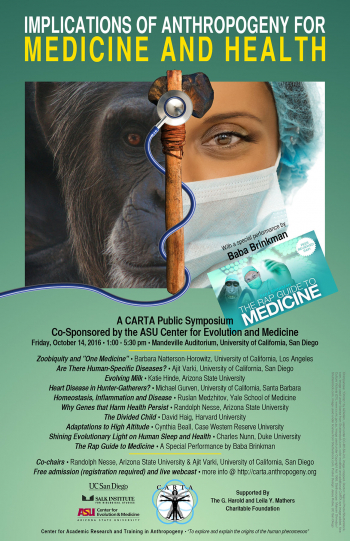Implications of Anthropogeny for Medicine and Health
Randolph Nesse, Arizona State University
Ajit Varki, UC San Diego School of Medicine
Summary
All living things are the product of evolutionary processes. Since the goals of the health sciences are to prevent disease, maintain health and treat illnesses, it follows that understanding of evolutionary mechanisms and processes in the context of human origins is of vital importance. New applications of evolutionary biology to medicine and health are developing fast, with special opportunities for contributions from anthropogeny. Exploring the constraints and trade-offs involved in the evolutionary transition to humans is crucial for understanding diseases of our species. This symposium brings together experts who discuss these advances as they apply to the prevention and treatment of various illnesses such as obesity and other metabolic diseases, sleep disorders, problems associated with reproductive health, and disorders resulting from inappropriate immune responses, viewed in the context of human origins.
In addition to our scholarly experts, award-winning rap artist and playwright, Baba Brinkman, takes the stage to perform select songs from his The Rap Guide to Medicine album.
Co-sponsored by the ASU Center for Evolution & Medicine

Media for each talk can be played by clicking on icons in the table below, or by clicking on the individual talk titles below and then the attachment file at the bottom of the page.
| Speakers | Media | Session |
|---|---|---|
 David Brenner  Pascal Gagneux |
|
Welcome |
 Randolph Nesse |
|
Opening Remarks |
 Barbara Natterson-Horowitz |
|
Zoobiquity and "One Medicine" Getting a bad diagnosis is about more than just having a disease. Merely hearing words like breast cancer, melanoma, stroke, septic shock, depression, and eating disorders activates high anxiety triggering an often painful and unsatisfactory search for an explanation. Self-recriminations, finger pointing, blame and shame contribute to patient suffering. Moreover, our culture's preoccupation with disease prevention has led to a widespread and dangerous fallacy: that "good" behavior in the form... read more |
 Ajit Varki |
|
Are there Human-Specific Diseases? Comparative medicine has a long and strong tradition, in which studies of naturally occurring diseases in other animals has shed much light on the origins and pathophysiology of human ailments. Less attention has been paid to the flip side of the coin, i.e., are there diseases that are preferentially or uniquely human? In our studies of the comparative biology of humans and other hominids (the so-called "great apes”), we have encountered several surprising examples in which common human... read more |
 Katie Hinde |
|
Evolving Milk Unlike WEIRD adults- Westernized, Educated, Industrial, Rich, Democratic- far removed from the ancestral conditions that shaped our bodies and behavior, the breastfed infant develops within an “adaptively relevant environment.” As an integrated food, medicine, and signal, milk nourishes, protects, and informs the developing neonate through nutrients, immunofactors, and hormones. Importantly, milk varies across species, populations, individuals, and across time. Although breast milk is described... read more |
 Michael Gurven |
|
Heart Disease in Hunter-Gatherers? Atherosclerosis and other chronic non-communicable diseases are commonly believed to have been rare among ancestral humans. Instead, they are often seen as recent consequences of modern environments and lifestyles. One important lens for viewing health and disease in evolutionary context is the biomedical study of subsistence-level societies living under relatively traditional conditions without modern amenities. In order to help understand whether heart disease is an ancient stalker or a... read more |
 Ruslan Medzhitov |
|
Homeostasis, Inflammation and Disease Homeostasis is a property of biological systems to maintain key parameters at the desired level, close to the set-point value in the face of external and internal perturbations. Homeostatic systems can have either fixed, or adjustable set points. The latter provide the benefit of flexibility but have a vulnerability of dysregulation, resulting in chronic diseases. The disease of homeostasis are invariably associated with inflammation. Inflammation is a protective response against infection,... read more |
 Randolph Nesse |
|
Why Genes that Harm Health Persist Why hasn’t natural selection eliminated genetic variations that harm health? The question is central to our ability to use new genetic technologies to improve health, but there are strong tendencies to provide simplistic single answers. The old answer has been that mutations happen and natural selection is not all-powerful. This is correct and important but only part of a full explanation. The idea that genes that cause disease also may have benefits is popular but not as widely applicable as... read more |
 David Haig |
|
The Divided Child My mother’s kin are not my father’s kin. This asymmetry results in conflicting selective forces acting on genes of maternal and paternal origin revealed in the phenomenon of genomic imprinting. Genes of paternal origin in a child are predicted to favor benefits to the child but reproductive costs to the child’s mother (or other matrilineal kin) whereas genes of maternal origin are predicted to favor benefits to the child’s mother. These intragenomic conflicts with be illustrated with disorders... read more |
 Cynthia Beall |
|
Adaptations to High Altitude The two major human populations that have adapted well to high altitude, the Tibetans and Andeans, have strikingly different phenotypes.” (West, 2012 p. 1229). The founders of contemporary indigenous highland populations moved into their stressful environment with an ancient oxygen homeostasis toolkit that we share with all multicellular animals. Our oldest single-celled ancestors evolved in the hypoxic conditions of the early oceans, our vertebrate and mammalian ancestors evolved in... read more |
 Charles Nunn |
|
Shining Evolutionary Light on Human Sleep and Health Scientists have made substantial progress in understanding the evolution of sleep across the Tree of Life, including in primates. Remarkably, evolutionary changes in sleep along the human lineage have been largely ignored. This omission is surprising given the extraordinary mental capacity and behavioral flexibility of humans, and the importance of sleep for cognitive performance. Based on new evolutionary analyses and studies of sleep in traditional human populations, I propose that human ... read more |
 Ajit Varki  Randolph Nesse  All Speakers |
|
Question and Answer Session, Closing Remarks |
 Baba Brinkman |
|
A Rap Guide to Medicine A Special Performance by Baba Brinkman Award-winning rap artist and playwright, Baba Brinkman, will perform select songs from his The Rap Guide to Medicine at the October 14, 2016 CARTA/ASU symposium, Implications of Anthropogeny for Medicine and Health. The Rap Guide to Medicine takes a hard-edged look at the roots of disease, tracing it back to the body’s evolutionary history. The Rap Guide to Medicine was vetted for scientific accuracy by several experts, led by Randolph M. Nesse,... read more |
| Attachment | Size |
|---|---|
| 174.06 KB | |
| 577.4 KB | |
| 712.64 KB | |
| 334.78 KB | |
| 616.67 KB |
If you enjoy this event, please consider supporting CARTA's quest to explore and explain the human phenomenon.


